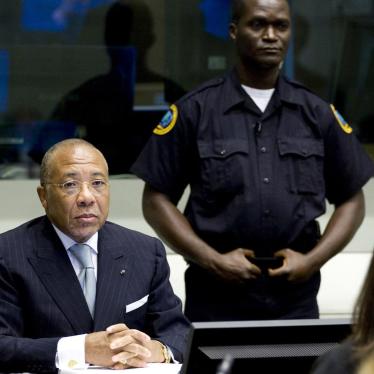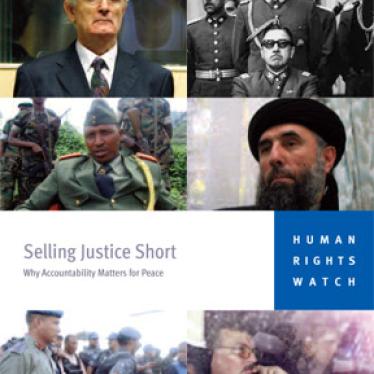|
December 1989 |
Charles Taylor, leader of the National Patriotic Front of Liberia (NPFL), launches a rebellion against the Samuel Doe-led government of Liberia. |
|
March 23, 1991 |
The Revolutionary United Front (RUF) launches a rebellion against the government of Sierra Leone, beginning of the country’s armed conflict. |
|
August 2, 1997 |
Taylor is sworn in as president of Liberia after years of civil war and an election in which there is an implicit threat that Taylor will resume armed conflict unless he is elected. |
|
January 16, 2002 |
The United Nations and government of Sierra Leone sign an agreement establishing the Special Court for Sierra Leone (SCSL). |
|
January 18, 2002 |
President Ahmad Tejan Kabbah of Sierra Leone declares the end of the Sierra Leone civil war. |
|
March 7, 2003 |
The Trial Chamber of the SCSL confirms a sealed indictment of Taylor on 17 counts of war crimes, crimes against humanity, and other serious violations of international law. |
|
June 4, 2003 |
The SCSL unseals Taylor’s indictment while Taylor is attending peace talks in Ghana to end the conflict in Liberia. |
|
July 23, 2003 |
Lawyers on behalf of Taylor file a motion asking the Trial Chamber to quash the indictment. |
|
August 11, 2003 |
Taylor steps down as president of Liberia and is flown to Nigeria, where he has been offered safe haven. He moves into a government guesthouse in Calabar. |
|
December 4, 2003 |
Interpol issues a “Red Notice,” which seeks Taylor’s arrest. |
|
May 31, 2004 |
The SCSL Appeals Chamber dismisses the motion brought on Taylor’s behalf to quash his indictment. |
|
May 5, 2005 |
While in Washington, D.C., President Olusegun Obasanjo of Nigeria states that he would consider supporting Taylor’s transfer to Liberia if a duly elected Liberian government made a formal request. |
|
November 23, 2005 |
Ellen Johnson-Sirleaf is declared the winner of the Liberian election and confirmed as the country's next president. |
|
March 16, 2006 |
The SCSL approves an amended indictment against Taylor, reducing the counts from 17 to 11. |
|
March 17, 2006 |
President Obasanjo’s office confirms in a statement that President Johnson-Sirleaf has made a formal request to extradite Taylor. |
|
March 25, 2006 |
President Obasanjo sends a special envoy to Liberia to inform President Johnson-Sirleaf that the “Government of Liberia is free to take former President Charles Taylor into its custody.” |
|
March 27, 2006 |
Taylor disappears from his home in Nigeria. |
|
March 29, 2006 |
Taylor is apprehended by Nigerian authorities at the Nigerian border with Cameroon. He is flown to Monrovia, Liberia, where he is arrested by the United Nations Mission in Liberia. He is then transferred to the SCSL in Freetown, Sierra Leone. |
|
March 30, 2006 |
The president of the SCSL asks to transfer Taylor’s trial to The Hague, citing concerns about the stability of the West African sub-region if Taylor was tried in Freetown. |
|
April 3, 2006 |
Taylor makes his initial appearance at the SCSL in Freetown. He pleads not guilty to all charges. |
|
June 16, 2006 |
The United Nations Security Council passes Resolution 1688, allowing the SCSL to transfer Taylor's case to The Hague. |
|
June 30, 2006 |
Taylor is transferred to The Hague. |
|
June 4, 2007 |
The prosecutor makes his opening statement before Trial Chamber II of the SCSL, which is using the facilities of the International Criminal Court in The Hague. Taylor boycotts the trial and dismisses his legal team. |
|
July 17, 2007 |
The SCSL principal defender assigns new counsel to Taylor. |
|
January 7, 2008 – February 27, 2009 |
The prosecution presents its case. In total, the prosecution calls 91 witnesses including 58 witnesses who testify to the alleged crimes committed, 29 insider witnesses who testify to alleged links between Taylor and the crimes, and 4 expert witnesses. Additional evidence includes written statements from four witnesses who testify to the crimes committed, and reports from two expert witnesses. |
|
April 7, 2009 |
Taylor’s defense attorneys make a submission of “No Case to Answer or Motion for Judgment of Acquittal” to the Trial Chamber, arguing that the prosecution failed to prove its case against Taylor. |
|
May 4, 2009 |
The Trial Chamber dismisses in its entirety the defense’s Motion for Judgment of Acquittal. |
|
July 13, 2009 |
The defense opens its case. |
|
July 14, 2009 – November 10, 2009 |
Taylor takes the stand in his own defense. Lead defense counsel Courtenay Griffiths conducts the direct-examination. |
|
November 10, 2009 – February 5, 2010 |
Lead prosecutor Brenda Hollis conducts the cross-examination of Taylor. |
|
February 15, 2010 – February 19, 2010 |
Defense lawyers conduct the re-examination of Taylor. |
|
May 17, 2010 |
The proceedings relocate from the International Criminal Court premises to the Special Tribunal for Lebanon premises in Leidschendam, on the outskirts of The Hague. |
|
May 20, 2010 |
The prosecution submits a motion to call three additional witnesses—Naomi Campbell, Carole White, and Mia Farrow—arguing that their testimony is necessary to prove that Taylor possessed rough diamonds, which he allegedly used to buy arms. |
|
August 5 – August 10, 2010 |
The three additional prosecution witnesses are called to the stand, bringing the number of prosecution witnesses to 94. |
|
October 22, 2010 |
The Trial Chamber orders the defense to finalize its case by November 12, 2010. Prosecution and defense are given until January 14, 2011 to submit their final trial briefs. |
|
November 12, 2010 |
The defense formally rests its case after presenting 21 witnesses. |
|
January 14, 2011 |
The prosecution submits its final trial brief by the court-mandated deadline. The defense does not meet the deadline, contending the court must decide on outstanding motions before it can properly submit its final brief. |
|
January 20, 2011 |
At a status conference, the Trial Chamber by majority opinion holds that the order to submit final trial briefs by January 14, 2011 will not be amended because outstanding defense motions were submitted only after the defense formally closed its case. |
|
February 3, 2011 |
Taylor’s defense team files its final trial brief after the Trial Chamber has issued its final decisions on the outstanding motions. |
|
February 7, 2011 |
The Trial Chamber by majority opinion declines to accept the defense’s final trial brief. |
|
February 8, 2011 |
The prosecution presents its closing arguments. Lead defense counsel Courtenay Griffiths leaves the courtroom after indicating to the judges that the defense was not prepared to take part in the closing arguments due to the rejection of its final trial brief. |
|
March 3, 2011 |
The Appeals Chamber reverses the decision of the Trial Chamber to reject the defense final brief and orders the Trial Chamber to schedule the defense’s closing arguments. |
|
March 9, 2011 – March 10, 2011 |
Defense presents its closing arguments. |
|
March 11, 2011 |
The Trial Chamber officially closes the trial phase of the Taylor case. The judges retire to begin deliberations for a final judgment. |
|
April 26, 2012 |
The court announces the verdict and releases a summary judgment in the Taylor case. Taylor is found guilty on all 11 counts of the indictment for aiding and abetting the commission of war crimes and crimes against humanity and for planning certain attacks in which these crimes were committed. |
|
May 16, 2012 |
The court holds sentencing arguments. Prosecution and defense are each given an hour to present their arguments, and Taylor is given a half hour to address the court. |
|
May 18, 2012 |
The court releases its full judgment, which totals over 2,500 pages. |
|
May 30, 2012 |
The court sentences Taylor to 50 years in prison. |






